Investigation of the Oxidation Behavior of Cr20Mn17Fe18Ta23W22 and Microdefects Evolution Induced by Hydrogen Ions before and after Oxidation
Abstract
:1. Introduction
2. Materials and Methods
2.1. Materials
2.2. Hydrogen Ions Irradiation Experiments
2.3. Microstructure Characterization
3. Results and Discussion
3.1. Microstructures of the Deposited Cr20Mn17Fe18Ta23W22 RHEA
3.2. Oxidation of Cr20Mn17Fe18Ta23W22 RHEA
3.3. Oxidized Cr20Mn17Fe18Ta23W22 Irradiated with Hydrogen Ions (60 eV)
4. Conclusions
Author Contributions
Funding
Institutional Review Board Statement
Informed Consent Statement
Data Availability Statement
Conflicts of Interest
References
- Maier, H.; Neu, R.; Schwarz-Selinger, T.; Von Toussaint, U.; Manhard, A.; Dürbeck, T.; Hunger, K. Tungsten heavy alloy: An alternative plasma-facing material in terms of hydrogen isotope retention. Nucl. Fusion 2020, 60, 126044. [Google Scholar] [CrossRef]
- Cherkeza, D.I.; Spitsynab, A.V.; Golubevaa, A.V.; Chernovc, V.M. Deuterium permeation through the low-activated V–4Cr–4Ti alloy under plasma irradiation. Nucl. Mater. Energy 2020, 23, 100756. [Google Scholar] [CrossRef]
- Wang, L.; Zhou, H.-S.; Liu, H.-D.; Xu, Q.; Oya, Y.; Zhao, M.-Z.; Tanabe, T.; Luo, G.-N. Studies on accelerated hydrogen isotopes permeation through plasma-facing components of fusion reactors. Phys. Scr. 2020, T171, 014032. [Google Scholar] [CrossRef]
- Vehovar, L. Hydrogen embrittlement of Microalloyed structural steels. Mater. Corros. 1994, 45, 349–354. [Google Scholar] [CrossRef]
- Humrickhouse, P.; Merrill, B.J. Tritium aspects of the fusion nuclear science facility. Fusion Eng. Des. 2018, 135, 302–313. [Google Scholar] [CrossRef]
- Wang, X.; Ran, G.; Wang, H.; Xiao, C.; Zhang, G.; Chen, C. Current Progress of Tritium Fuel Cycle Technology for CFETR. J. Fusion Energy 2018, 38, 125–137. [Google Scholar] [CrossRef]
- Zhou, H.-S.; Liu, H.-D.; Wang, L.; Yang, X.; Oya, Y.; Zhao, M.-Z.; Tanabe, T.; Xu, Y.-P.; Yuan, X.-G.; Li, B.; et al. A tritium permeation ‘short cut’ for plasma-facing components of fusion reactors. Nucl. Fusion 2019, 59, 014003. [Google Scholar] [CrossRef]
- Houben, A.; Rasinski, M.; Linsmeier, C. Hydrogen Permeation in Fusion Materials and the Development of Tritium Permeation Barriers. Plasma Fusion Res. 2020, 15, 2405016. [Google Scholar] [CrossRef]
- Urabe, Y.; Hashizume, K.; Otsuka, T.; Sakamoto, K. Tritium Permeation through Ce-ODS Steel. Fusion Sci. Technol. 2020, 76, 392–397. [Google Scholar] [CrossRef]
- An, X.; Zhu, T.; Wan, M.; Li, Y.; Wang, Q.; Zhang, P.; Liu, J.; Song, Y.; Zhang, Z.; Wang, B.; et al. Investigation of the interaction between hydrogen and irradiation defects in titanium by using positron annihilation spectroscopy. Int. J. Hydrogen Energy 2021, 46, 13162–13170. [Google Scholar] [CrossRef]
- Zhang, W.; Guo, L.; Shen, Z.; Xin, J.; Huang, Q.; Wei, Y.; Long, Y.; Zhou, X.; Chen, C. Evolution of Dislocation Loops Induced by Different Hydrogen Irradiation Conditions in Reduced-Activation Martensitic Steel. Materials 2018, 11, 2276. [Google Scholar] [CrossRef] [PubMed] [Green Version]
- Lu, E.; Makkonen, I.; Mizohata, K.; Li, Z.; Räisänen, J.; Tuomisto, F. Effect of interstitial carbon on the evolution of early-stage irradiation damage in equi-atomic FeMnNiCoCr high-entropy alloys. J. Appl. Phys. 2020, 127, 025103. [Google Scholar] [CrossRef]
- Ramachandran, R.; David, C.; Magudapathy, P.; Rajaraman, R.; Govindaraj, R.; Amarendra, G. Study of defect complexes and their evolution with temperature in hydrogen and helium irradiated RAFM steel using positron annihilation spectroscopy. Fusion Eng. Des. 2019, 142, 55–62. [Google Scholar] [CrossRef]
- Niu, C.; LaRosa, C.R.; Miao, J.; Mills, M.J.; Ghazisaeidi, M. Magnetically-driven phase transformation strengthening in high entropy alloys. Nat. Commun. 2018, 9, 1–9. [Google Scholar] [CrossRef]
- Duan, Y.; Song, L.; Cui, Y.; Pang, H.; Zhang, X.; Wang, T. FeCoNiCuAl high entropy alloys microwave absorbing materials: Exploring the effects of different Cu contents and annealing temperatures on electromagnetic properties. J. Alloy. Compd. 2020, 848, 156491. [Google Scholar] [CrossRef]
- Kim, J.; Wakai, A.; Moridi, A. Materials and manufacturing renaissance: Additive manufacturing of high-entropy alloys. J. Mater. Res. 2020, 35, 1963–1983. [Google Scholar] [CrossRef]
- Patel, D.; Richardson, M.; Jim, B.; Akhmadaliev, S.; Goodall, R.; Gandy, A. Radiation damage tolerance of a novel metastable refractory high entropy alloy V2.5Cr1.2WMoCo0.04. J. Nucl. Mater. 2020, 531, 152005. [Google Scholar] [CrossRef]
- Chang, S.; Tseng, K.-K.; Yang, T.-Y.; Chao, D.-S.; Yeh, J.-W.; Liang, J.-H. Irradiation-induced swelling and hardening in HfNbTaTiZr refractory high-entropy alloy. Mater. Lett. 2020, 272, 127832. [Google Scholar] [CrossRef]
- Senkov, O.N.; Miracle, D.B.; Chaput, K.J.; Couzinie, J.-P. Development and exploration of refractory high entropy alloys—A review. J. Mater. Res. 2018, 33, 3092–3128. [Google Scholar] [CrossRef] [Green Version]
- Xu, Z.; Ma, Z.; Wang, M.; Chen, Y.; Tan, Y.; Cheng, X. Design of novel low-density refractory high entropy alloys for high-temperature applications. Mater. Sci. Eng. A 2019, 755, 318–322. [Google Scholar] [CrossRef]
- Wang, M.; Ma, Z.L.; Xu, Z.Q.; Cheng, X.W. Designing VxNbMoTa refractory high-entropy alloys with improved properties for high-temperature applications. Scr. Mater. 2021, 191, 131–136. [Google Scholar] [CrossRef]
- Moschetti, M.; Xu, A.L.; Schuh, B.; Hohenwarter, A.; Couzinié, J.-P.; Kruzic, J.J.; Bhattacharyya, D.; Gludovatz, B. On the Room-Temperature Mechanical Properties of an Ion-Irradiated TiZrNbHfTa Re-fractory High Entropy Alloy. J. Miner. Met. Mater. Soc. 2020, 72, 130–138. [Google Scholar] [CrossRef]
- Bhandari, U.; Zhang, C.; Zeng, C.; Guo, S.; Yang, S. Computational and experimental investigation of refractory high entropy alloy Mo15Nb20Re15Ta30W20. J. Mater. Res. Technol. 2020, 9, 8929–8936. [Google Scholar] [CrossRef]
- Wei, Y.; Fu, Y.; Pan, Z.-M.; Ma, Y.-C.; Cheng, H.-X.; Zhao, Q.-C.; Luo, H.; Li, X.-G. Influencing factors and mechanism of high-temperature oxidation of high-entropy alloys: A review. Int. J. Miner. Met. Mater. 2021, 28, 915–930. [Google Scholar] [CrossRef]
- Tsai, K.-Y.; Tsai, M.-H.; Yeh, J.-W. Sluggish diffusion in Co–Cr–Fe–Mn–Ni high-entropy alloys. Acta Mater. 2013, 61, 4887–4897. [Google Scholar] [CrossRef]
- Huang, E.-W.; Chou, H.-S.; Tu, K.N.; Hung, W.-S.; Lam, T.-N.; Tsai, C.-W.; Chiang, C.-Y.; Lin, B.-H.; Yeh, A.-C.; Chang, S.-H.; et al. Element Effects on High-Entropy Alloy Vacancy and Heterogeneous Lattice Distortion Subjected to Quasi-equilibrium Heating. Sci. Rep. 2019, 9, 1–10. [Google Scholar] [CrossRef] [Green Version]
- Dąbrowa, J.; Danielewski, M. State-of-the-Art Diffusion Studies in the High Entropy Alloys. Metals 2020, 10, 347. [Google Scholar] [CrossRef] [Green Version]
- Cox, M.G.C.; McEnaney, B.; Scott, V.D. A chemical diffusion model for partitioning of transition elements in oxide scales on alloys. Philos. Mag. 1972, 26, 839–851. [Google Scholar] [CrossRef]
- Lobnig, R.E.; Schmidt, H.P.; Hennesen, K.; Grabke, H.J. Diffusion of cations in chromia layers grown on iron-base alloys. Oxid. Met. 1992, 37, 81–93. [Google Scholar] [CrossRef]
- Feng, S.J.; Wang, Y.; Zhang, C.; Luo, C.; Xu, J.; Suo, J. Preparation of Al2O3/Cr2O3 tritium permeation barrier with combination of pack cementation and sol-gel methods. Fusion Eng. Des. 2018, 131, 1–7. [Google Scholar] [CrossRef]
- Zhu, T.; Wang, B.; Yuan, D.; Jin, S.; Zhang, P.; Lu, E.; Song, L.; Liu, Y.; Ma, H.; Zhang, Q.; et al. Effect of temperature and dose on vacancy-defect evolution in 304L stainless steel irradiated by triple ion beam. J. Nucl. Mater. 2018, 512, 94–99. [Google Scholar] [CrossRef]
- Zhang, J.; Zhang, X.; Li, Y.; Du, Q.; Liu, X.; Qi, X. High-entropy oxides 10La2O3-20TiO2-10Nb2O5-20WO3-20ZrO2 amorphous spheres prepared by containerless solidification. Mater. Lett. 2019, 244, 167–170. [Google Scholar] [CrossRef]
- Chen, K.; Pei, X.; Tang, L.; Cheng, H.; Li, Z.; Li, C.; Zhang, X.; An, L. A new five-component entropy-stabilized fluorite oxide. J. Eur. Ceram. Soc. 2018, 38, 4161–4164. [Google Scholar] [CrossRef]
- Kim, Y.-K.; Joo, Y.-A.; Kim, H.S.; Lee, K.-A. High temperature oxidation behavior of Cr-Mn-Fe-Co-Ni high entropy alloy. Intermetallics 2018, 98, 45–53. [Google Scholar] [CrossRef]
- Jackson, P.R.S.; Wallwork, G.R. High temperature oxidation of iron-manganese-aluminum based alloys. Oxid. Met. 1984, 21, 135–170. [Google Scholar] [CrossRef]
- Zhu, G.; Liu, Y.; Ye, J. Early high-temperature oxidation behavior of Ti(C,N)-based cermets with multi-component AlCo-CrFeNi high-entropy alloy binder. Int. J. Refract. Met. Hard Mater. 2014, 44, 35–41. [Google Scholar] [CrossRef]
- Senkov, O.N.; Senkova, S.V.; Dimiduk, D.M.; Woodward, C.; Miracle, D.B. Oxidation behavior of a refractory NbCrMo0.5Ta0.5TiZr alloy. J. Mater. Sci. 2012, 47, 6522–6534. [Google Scholar] [CrossRef]
- Kai, W.; Li, C.; Cheng, F.; Chu, K.; Huang, R.; Tsay, L.; Kai, J.; Kai, W.; Li, C.; Cheng, F.; et al. The oxidation behavior of an equimolar FeCoNiCrMn high-entropy alloy at 950 °C in various oxygen-containing atmospheres. Corros. Sci. 2016, 108, 209–214. [Google Scholar] [CrossRef]
- Marrocchelli, D.; Sun, L.; Yildiz, B. Dislocations in SrTiO3: Easy To Reduce but Not so Fast for Oxygen Transport. J. Am. Chem. Soc. 2015, 137, 4735–4748. [Google Scholar] [CrossRef]
- Love, G. Dislocation pipe diffusion. Acta Met. 1964, 12, 731–737. [Google Scholar] [CrossRef]
- Zhang, C.; Wu, Y.; You, L.; Cao, X.; Lu, Z.; Song, X. Investigation on the activation mechanism of hydrogen absorption in TiZrNbTa high entropy alloy. J. Alloy. Compd. 2018, 781, 613–620. [Google Scholar] [CrossRef]
- Li, Q.; Mo, L.-B.; Wang, J.; Yan, K.; Tang, T.; Rao, Y.-C.; Yao, W.-Q.; Cao, J.-L. Performances of Cr2O3 –hydrogen isotopes permeation barriers. Int. J. Hydrogen Energy 2015, 40, 6459–6464. [Google Scholar] [CrossRef]
- Zhang, P.; Jin, S.; Lu, E.; Wang, B.; Zheng, Y.; Yuan, D.; Cao, X. Effect of annealing on VmHn complexes in hydrogen ion irradiated Fe and Fe-0.3%Cu alloys. J. Nucl. Mater. 2015, 459, 301–305. [Google Scholar] [CrossRef]
- Xu, Y.-P.; Liu, H.-D.; Lyu, Y.-M.; Zhou, H.-S.; Ding, F.; Li, Z.-D.; Li, X.-C.; Wang, J.; Yuan, X.-G.; Wang, X.-L.; et al. Effects of high-energy C ions irradiation on the deuterium retention behavior in V-5Cr-5Ti. J. Nucl. Mater. 2018, 509, 513–516. [Google Scholar] [CrossRef]




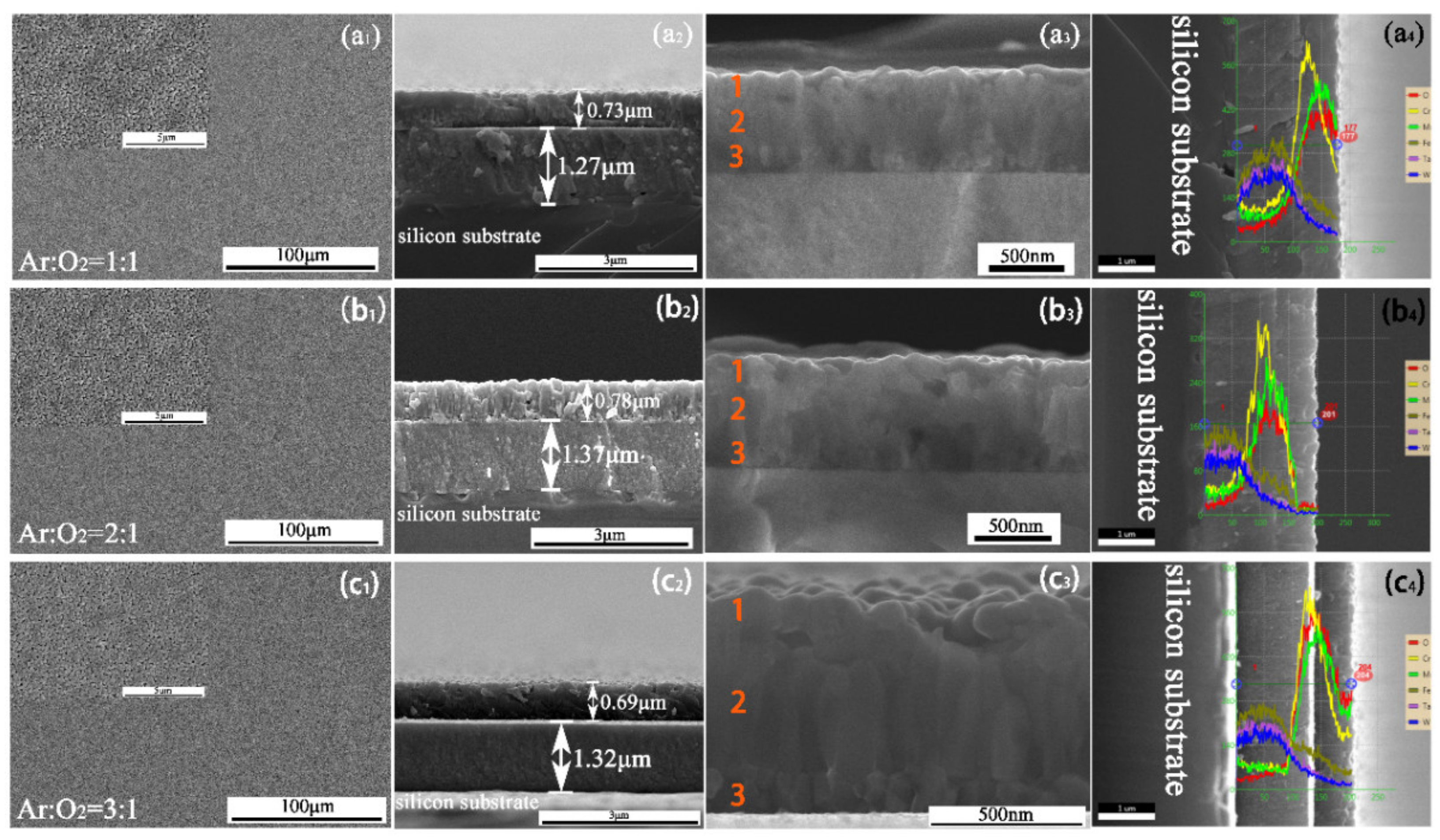


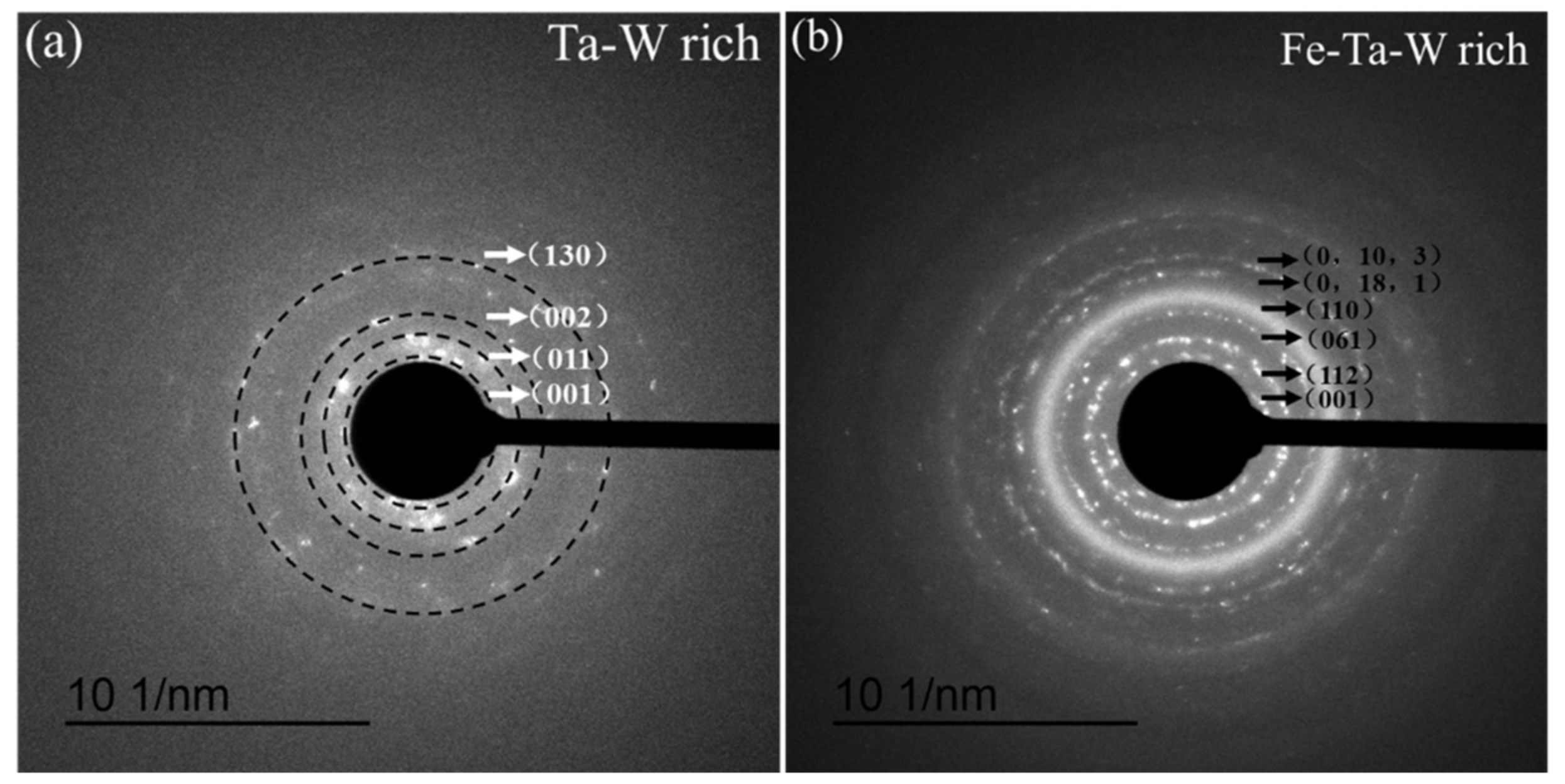
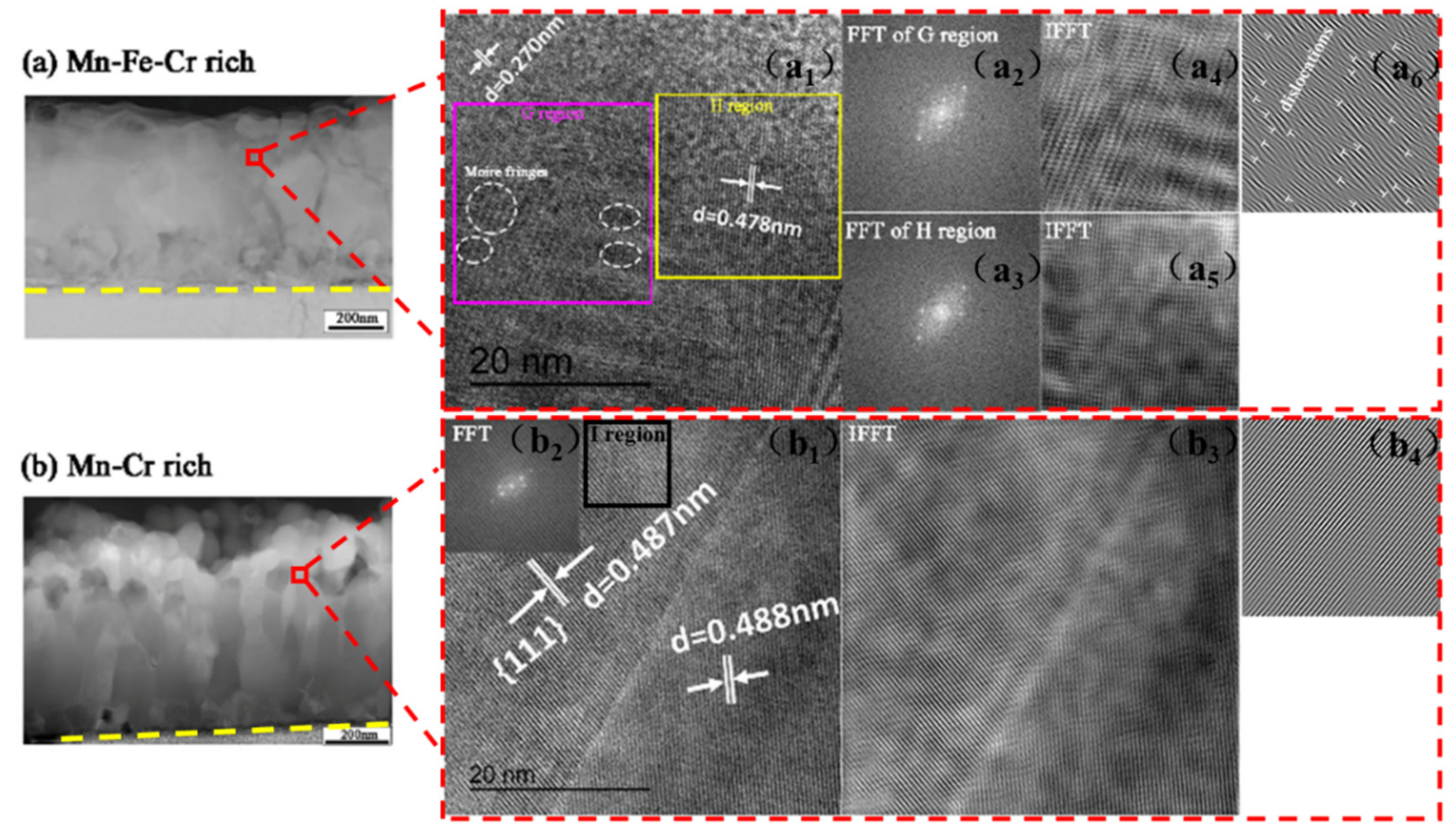
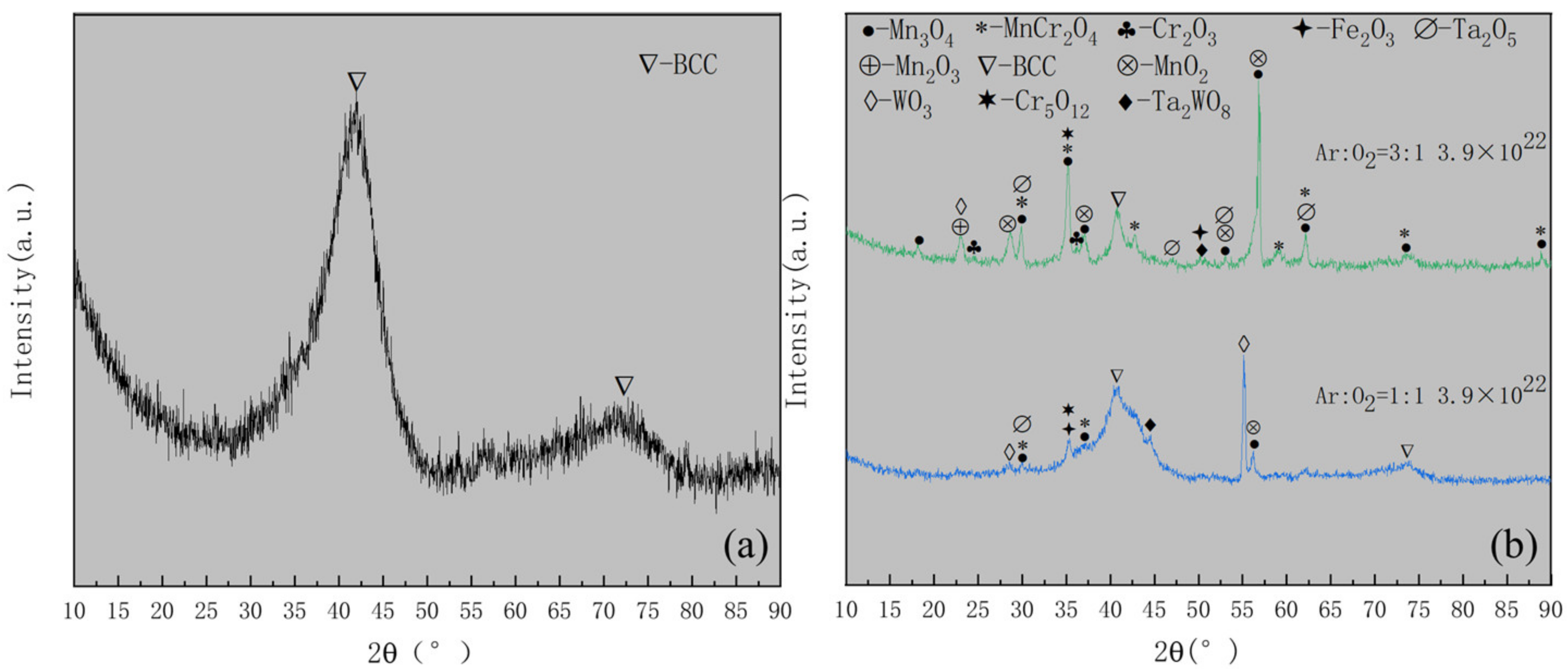
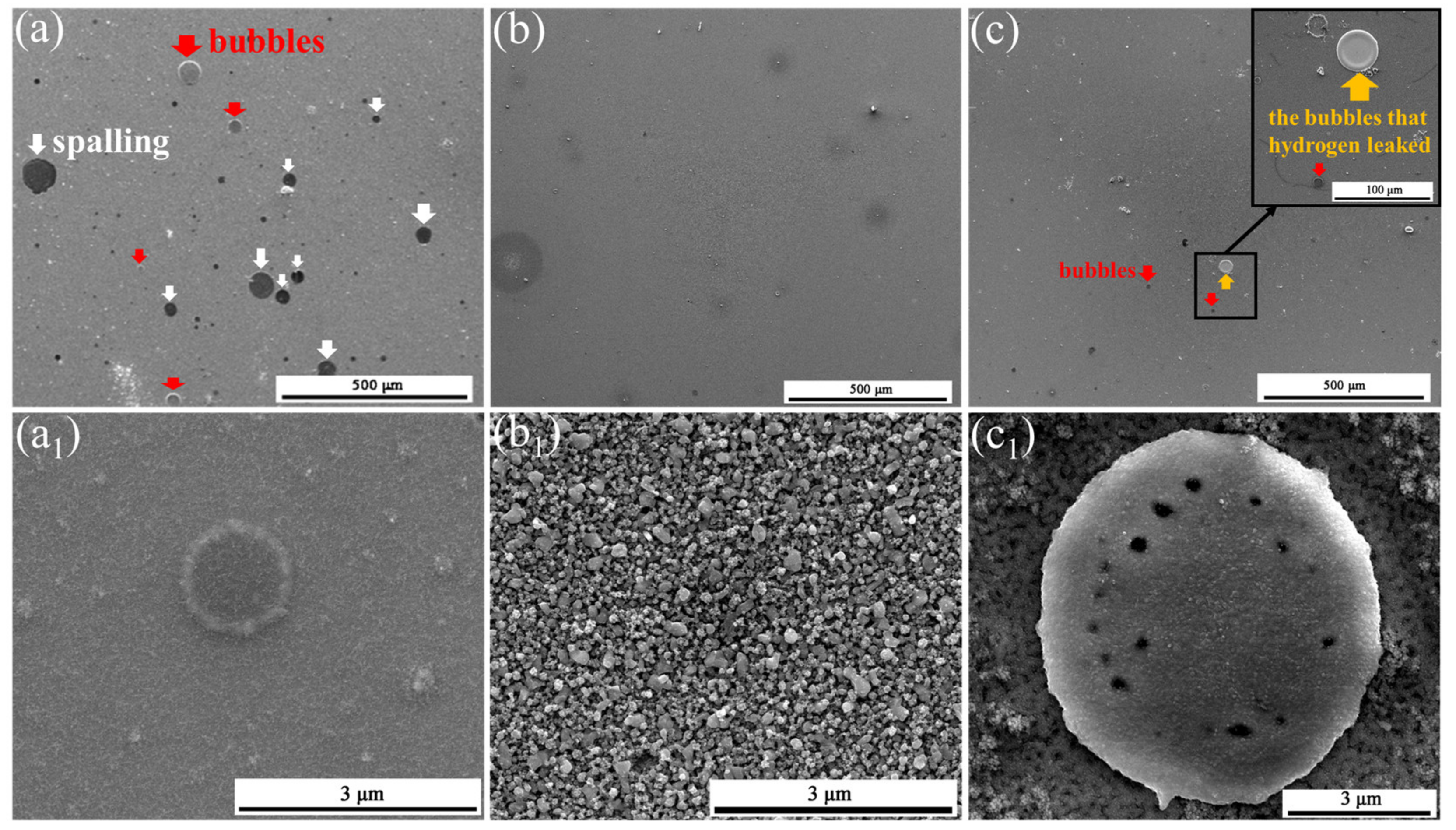
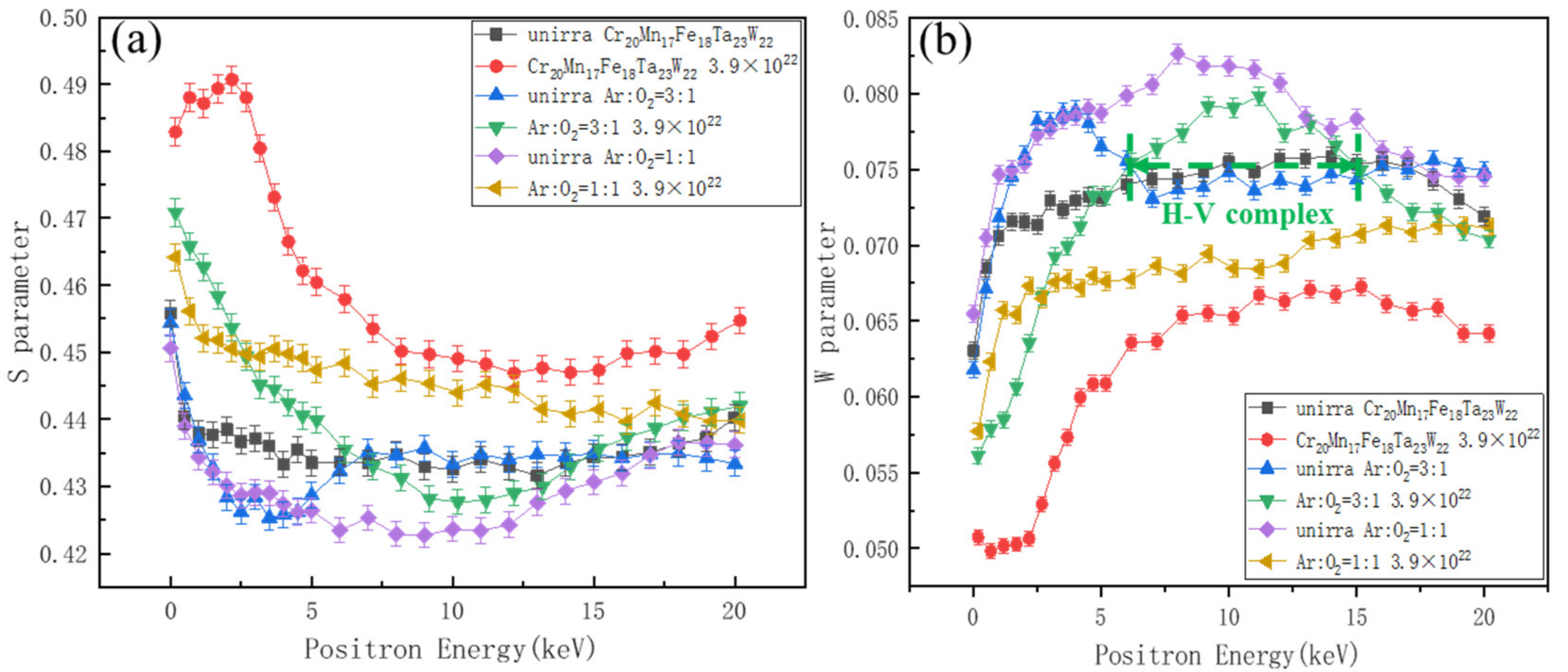
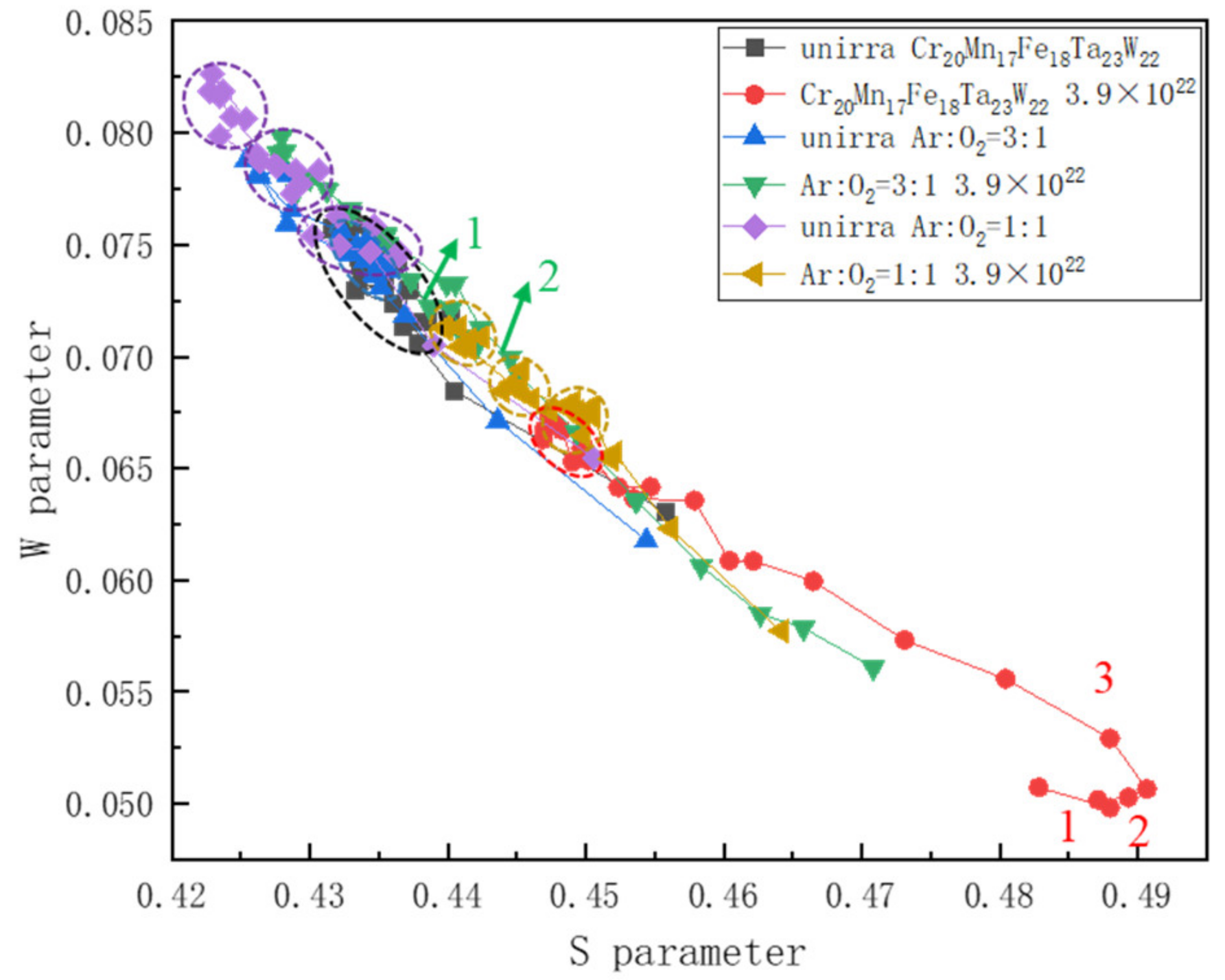
| Elements | O | Cr | Mn | Fe | Ta | W |
|---|---|---|---|---|---|---|
| at.% | ||||||
| EDS (Region 1) | 25.69 | 21.83 | 23.84 | 25.47 | 1.54 | 1.63 |
| - | 29.38 | 32.08 | 34.28 | 2.07 | 2.19 | |
| XPS | 65.33 | 5.06 | 18.31 | 9.56 | 0.25 | 0.47 |
| Element | Cr | Mn | Fe | Ta | W |
|---|---|---|---|---|---|
| Pauling electronegativity | 1.66 | 1.55 | 1.83 | 1.50 | 2.36 |
| Samples | Elements | O | Cr | Mn | Fe | Ta | W |
|---|---|---|---|---|---|---|---|
| at.% | |||||||
| HT1 | EDS | 42.84 | 23.05 | 30.42 | 1.25 | 0.79 | 1.66 |
| - | 40.32 | 53.21 | 2.19 | 1.38 | 2.9 | ||
| XPS | 66.98 | 7.9 | 21.08 | 1.89 | 0.62 | 1.51 | |
| HT2 | EDS | 43.06 | 23.32 | 30.75 | 1.01 | 0.59 | 1.26 |
| - | 40.96 | 54 | 1.78 | 1.04 | 2.22 | ||
| XPS | 65.98 | 9.23 | 20.82 | 2.72 | 0.48 | 0.76 | |
| HT3 | EDS | 42.37 | 23.92 | 29.98 | 1.63 | 0.56 | 1.54 |
| - | 41.51 | 52.02 | 2.83 | 0.97 | 2.67 | ||
| XPS | 65.8 | 8.78 | 20.52 | 2.76 | 1.02 | 1.12 | |
Publisher’s Note: MDPI stays neutral with regard to jurisdictional claims in published maps and institutional affiliations. |
© 2022 by the authors. Licensee MDPI, Basel, Switzerland. This article is an open access article distributed under the terms and conditions of the Creative Commons Attribution (CC BY) license (https://creativecommons.org/licenses/by/4.0/).
Share and Cite
Wu, B.-Z.; Zhu, T.; Cao, X.-Z.; Yang, Z.-M.; Zhang, K.; Gou, F.-J.; Wang, Y. Investigation of the Oxidation Behavior of Cr20Mn17Fe18Ta23W22 and Microdefects Evolution Induced by Hydrogen Ions before and after Oxidation. Materials 2022, 15, 1895. https://doi.org/10.3390/ma15051895
Wu B-Z, Zhu T, Cao X-Z, Yang Z-M, Zhang K, Gou F-J, Wang Y. Investigation of the Oxidation Behavior of Cr20Mn17Fe18Ta23W22 and Microdefects Evolution Induced by Hydrogen Ions before and after Oxidation. Materials. 2022; 15(5):1895. https://doi.org/10.3390/ma15051895
Chicago/Turabian StyleWu, Bao-Zhen, Te Zhu, Xing-Zhong Cao, Zhao-Ming Yang, Kun Zhang, Fu-Jun Gou, and Yuan Wang. 2022. "Investigation of the Oxidation Behavior of Cr20Mn17Fe18Ta23W22 and Microdefects Evolution Induced by Hydrogen Ions before and after Oxidation" Materials 15, no. 5: 1895. https://doi.org/10.3390/ma15051895






